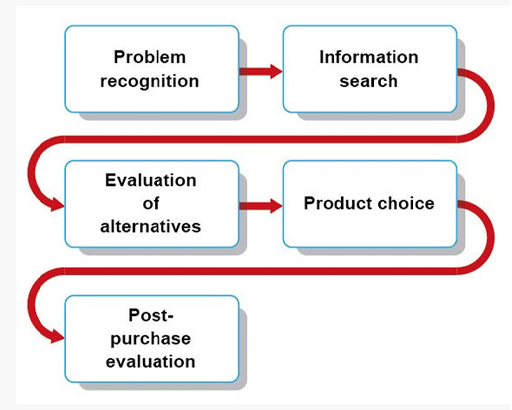1.5 You as a customer
Consider your own behaviour as a customer. As well as having customers ourselves, we all act as customers in marketing exchanges every day. Learning more about customer behaviour can improve the way we participate in these exchanges, so we become better at satisfying our needs.
A popular model in the study of customers sees buyer behaviour as a series of stages (Solomon, 2018) , as shown in Figure 3. The first stage in the model is the potential buyer realising they have a problem (such as hunger), which is called ‘problem recognition’. The second stage involves considering different ways of solving this problem, which can involve some investigation (for instance, finding out if there is a sandwich shop nearby). The technical term for this second stage is ‘information search’. The buyer behaviour model might help you reflect on the role of information search in your own purchases. It might even suggest new ways of dealing with a situation. Do you spend enough time investigating alternatives, or is convenience more important to you?
A good example of the importance of an information search is buying insurance. Problem recognition often arrives in the form of a reminder that the current insurance policy is about to expire. Having recognised this problem, many customers in the UK opt for the convenience of just renewing their policy with the same provider each year (Collinson, 2017), but this can be an expensive option. In a market where competitors attract new business with discounts, existing customers often end up paying more. It therefore pays to shop around or, in the language of the model, to engage in extensive information search, in the hope of getting a better deal.
Activity 4 Your behaviour as a customer
In this activity you will explore the reasons for an aspect of your current customer behaviour. This will help you understand the practical challenges facing marketers trying to change customer behaviour. Take this poll to see how your insurance renewal behaviour compares to that of other learners. Answer with reference to the last kind of recurring insurance you bought (whether house, contents, car or some other high-value item). If you don’t buy insurance, answer about some other form of regular service you purchase, such as a phone contract that comes up for renewal after a certain period of time. Once you have answered, you will be able to see how others have voted.
Discussion
Has this poll started you thinking about other decisions you make as a consumer? Are there ways in which a model like the stage model of buyer behaviour (Figure 3) might help you make better decisions?

